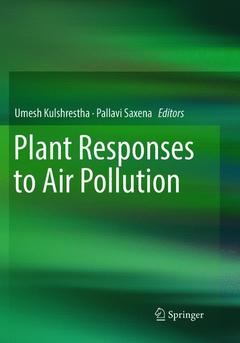Plant Responses to Air Pollution, Softcover reprint of the original 1st ed. 2016
Coordonnateurs : Kulshrestha Umesh, Saxena Pallavi

This book focuses upon air pollution, types of air pollutants and their impact on plant physiological and biochemical systems. The book begins with a brief background on air pollution and continues with a discussion on different types, effects, and solutions to the pollution. The chapters that follow, explore the different effects of pollution on chloroplasts, respiration, biochemistry and physiology of plant cells. Moreover, it covers the basic concepts of atmospheric transport and transformations of pollutants, and issues of global change and the use of science in air pollution policy formulation. It also emphasises about the effects of air pollutants in altering plant response to common stresses, both abiotic and biotic - fields by giving the focus on the physiology of plant. This book act as a valuable tool for students in Environmental Science, Biological Science and Agriculture. It will be unique to environmental consultants, researchers and other professionals involved in airquality and plant related research.
During past few decades, air pollution and poor air quality have been the issues of common concerns. Degraded air has adverse effects on various system of plants by creating a stress which develops biochemical and physiological disorder in plants. Chronic diseases and/or lower yield have reported consequences of air pollution effect. A large number of biochemical and physiological parameters have been used to assess impact of air pollution on plant health. Photosynthetic machinery and respiratory system are the most affected domain of plants. However, the survival of plants depend on various internal and external factors such as plant community, types of air pollutants, geographical region, meteorological conditions and soil moisture etc. Plants respond to both biotic and abiotic stresses accordingly. Many tolerant plants survive easily even in higher air pollution region. Certain plant species absorbs selected gaseous air pollutants and henceplants are effective tool for air pollution remediation.
Umesh Kulshrestha is a professor at the School of Environmental Sciences, Jawaharlal Nehru University, New Delhi. He is Deputy Director of South Asia Nitrogen Center. He has 22 years of experience in Environmental Sciences. His area of expertise includes aerosol and precipitation chemistry relevant to climate change, air pollution and plant health, reactive nitrogen, air pollution chemistry and transport, atmospheric depositions and biogeochemical cycle etc. Prof. Kulshrestha is a recipient of the START Young Scientist Award by IGBP-START, USA, Thomas Kuhn Honor Pin by IUAPPA and International Academy of Sciences, CSIR Young Scientist Award, and MS Krishnan Gold Medal by the Indian Geophysical Union (IGU). Also, he is a Fellow of IGU. He has published a number of papers which have been widely cited. He has been associated with various international and national programmes on atmospheric science including Indian Ocean Experiment (INDOEX), Asian Brown Cloud (ABC), IGAC-DEBITS-CAD (Composition of Asian Deposition), Composition of Asian Aerosol and Precipitation (CAAP), Surya, ISRO-GBP-Integrated Campaign on Aerosol Radiation Budget (ICARB), etc.
Pallavi Saxena is a Young Scientist at School of Environmental Sciences, Jawaharlal Nehru University, from 2014 onwards. She has done her postdoc from the Space and Atmospheric Sciences Division, Physical Research Laboratory (PRL), Ahmedabad, Gujarat. She has completed her doctor of philosophy in environmental science from the University of Delhi on the topic “Effect of Photochemical Pollutants on Plant Species” in 2013. Her area of interest is air pollution and plant physiology. She has been working in this area for the last 9 years. She has also been awarded University Grants Commission Junir Research Fellowship (UGC, JRF) (2007–2008), Jawaharlal Nehru Doctoral Scholarship (2009–2010) and Council of Scientific and Industrial Research Senior Research Fellowship (CSIR SRF) (2012–2013) d
Date de parution : 06-2018
Ouvrage de 195 p.
17.8x25.4 cm
Date de parution : 11-2016
Ouvrage de 195 p.
17.8x25.4 cm
